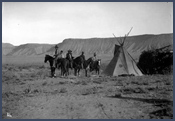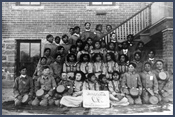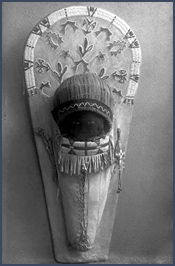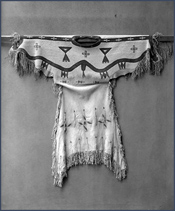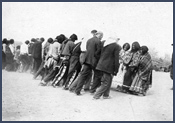Peoples of the Mesa Verde Region
The Historic Period: Late A.D. 1700s to Mid-1900sUte
In the late 1700s, Utes occupied eastern Utah, the western two-thirds of Colorado (including the entire Mesa Verde region), and parts of north-central New Mexico. By the end of this period, they were confined to three reservations that represented a very small fraction of traditional Ute territory. 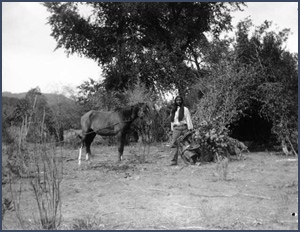
Before being confined to reservations, Ute Indians moved from camp to camp in their seasonal rounds. Here a Ute man stands with his horse in front of a wickiup. Another shelter is in the far left background. (See enlarged photograph.) In the early part of the Historic period, Ute culture continued to be based on hunting and gathering, with a seasonal round that took them to the mountains in the summer and to low-lying canyons in the winter. They sometimes traveled up to 400 miles between their seasonal camps. Utes also interacted with Plains Indians along the east side of the Rocky Mountains and as a result were heavily influenced by Plains Indian culture. After acquiring horses from the Spanish, the Utes became mounted raiders, traveling throughout the Rocky Mountains and onto the eastern plains. There they hunted buffalo and acquired other traits common to Plains Indian groups, including the use of teepees and distinctive styles of clothing. From 1849 to the 1880s, many treaties were signed with the United States government, some of them in response to the discovery of gold and silver on Ute lands. These treaties resulted in the loss of most of the traditional Ute territory—lands which for many generations had sustained the Ute people. In the Mesa Verde region, the end result was the establishment of two reservations: the Southern Ute Reservation in 1877 and the Ute Mountain Ute Reservation in the mid-1890s. In addition, the Uintah-Ouray Reservation was established in east-central Utah, outside the Mesa Verde region. For nomadic people who traveled over a wide territory to obtain food and other necessities, confinement to small tracts of land was an extreme hardship that threatened their very existence. 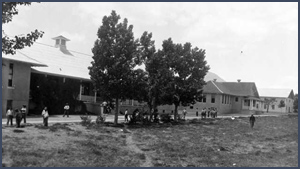
The Towaoc Indian Agency on the Ute Mountain Ute Reservation, circa 1900–1920. (See enlarged photograph.) The early twentieth century brought immense changes to the Ute way of life. Confined to reservations, the people gradually made the shift from hunting and gathering to an economy based on agriculture and livestock. As the regional economy began to diversify in the mid-twentieth century, opportunities for the Ute people increased as well, with some individuals working for wages in area businesses.
Visit the Ute Mountain Ute and Southern Ute Web sites for territorial maps and detailed tribal histories. |
|
 DONATE TODAY
DONATE TODAY

